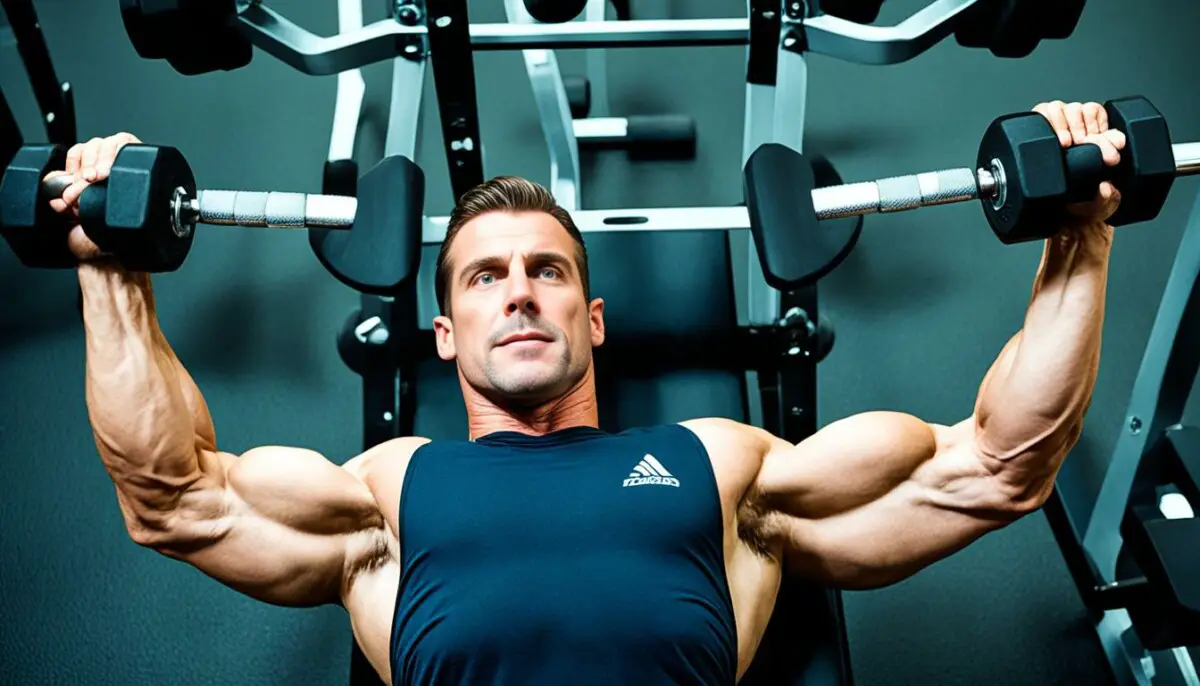Last Updated on 3 months by Francis
Converting from a chest press to a bench press can be an effective way to enhance your workouts and improve strength and muscle development. While the two exercises target similar muscle groups, there are important differences to consider.
The chest press is a machine-based exercise commonly found in gyms. It allows for controlled and stable movements, making it suitable for beginners or individuals with specific limitations. On the other hand, the bench press is a more versatile exercise that is typically performed with a barbell on a flat, incline, or decline bench. It requires more balance, stability, and coordination.
If you’re looking to transition from a chest press to a bench press, it’s important to understand the proper technique and progression. Starting with lighter weights and focusing on developing strength, stability, and form will help you safely adapt to the bench press.
Contents
Key Takeaways:
- Converting from a chest press to a bench press can enhance your workouts.
- The chest press is a machine-based exercise, while the bench press is typically performed with a barbell.
- The bench press requires more balance, stability, and coordination compared to the chest press.
- Transitioning to the bench press should be done gradually, starting with lighter weights and focusing on proper form.
- Consult with a qualified professional to ensure proper technique and avoid injuries during the transition.
Understanding the Bench Press
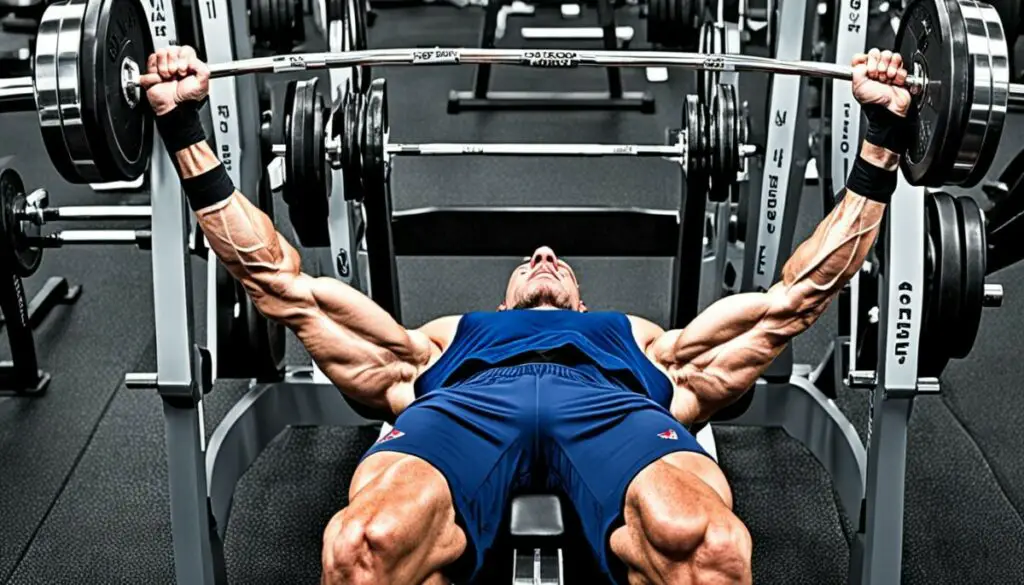
The bench press is a popular upper body exercise that specifically targets the chest, shoulders, and triceps. It is typically performed using a barbell on a flat, incline, or decline bench. The bench press is known for its ability to build strength and size in the upper body, making it a staple in many workout routines.
There are various variations of the bench press, each offering unique benefits and targeting different muscle groups. Some popular variations include:
- Dumbbell Bench Press: This variation involves using dumbbells instead of a barbell, allowing for a greater range of motion and increased stabilization.
- Cable Bar Bench Press: In this variation, the barbell is replaced with a cable machine, providing constant tension throughout the movement.
- Smith Machine Bench Press: The Smith machine allows for a guided barbell path, making it a good option for beginners or individuals with limited stability.
Proper technique and form are crucial when performing the bench press to prevent injuries and maximize results. Here are some key tips for executing the bench press correctly:
- Position yourself on the bench with your feet planted firmly on the ground.
- Grip the barbell with a slightly wider than shoulder-width grip, ensuring your wrists are straight and aligned with your forearms.
- Lower the barbell towards your mid-chest, maintaining control and keeping your elbows tucked in.
- Push the barbell back up to the starting position, fully extending your arms without locking out your elbows.
Remember to breathe properly throughout the movement, exhaling as you push the weight up and inhaling as you lower it down.
| Benefits of Bench Press | Common Mistakes to Avoid |
|---|---|
|
|
“The bench press is a classic exercise that builds both strength and size in the upper body. It should be a staple in any well-rounded workout routine.”
Exploring the Chest Press
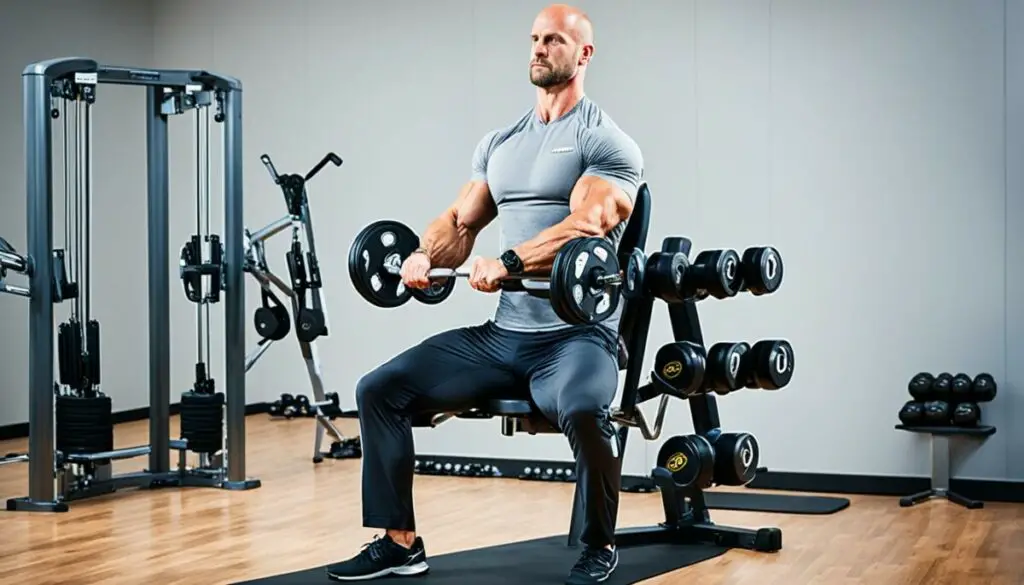
The chest press is a machine-based exercise commonly found in gyms. It is designed to mimic the pressing motion of the bench press but provides a more controlled and stable environment. The chest press can be performed using various machines, such as cable machines, plate-loaded machines, or suspended cables. It allows for different body positions and variations to target the chest muscles effectively.
One popular variation of the chest press is the machine chest press, which uses a guided motion and often includes back support. This can help beginners or individuals with limited stability to focus solely on the chest muscles without worrying about balance or coordination.
Another variation is the incline chest press, which targets the upper chest muscles more intensively. By adjusting the bench angle, you can increase or decrease the emphasis on specific areas of your chest.
The machine chest press is an effective exercise for isolating and targeting the chest muscles. It allows you to adjust the resistance and range of motion according to your fitness level and goals. Plus, the guided movement provides stability, reducing the risk of injury.
Benefits of the Chest Press Machine:
- Provides a controlled and stable environment
- Targets the chest muscles effectively
- Adjustable resistance and range of motion
- Reduces the risk of injury with guided movement
Chest Press Technique:
When performing the chest press, it’s essential to maintain proper technique and form to maximize its effectiveness.
- Adjust the seat height or bench angle to align your chest with the handles.
- Grasp the handles with a shoulder-width grip and keep your elbows slightly bent.
- Engage your core and maintain a stable position throughout the exercise.
- Exhale and push the handles forward until your arms are fully extended but not locked.
- Pause for a moment, then slowly return to the starting position while inhaling.
- Repeat for the desired number of repetitions.
Remember to start with a weight that challenges you but allows you to maintain proper form throughout the exercise. Gradually increase the resistance as your strength and muscle endurance improve.
| Chest Press Variations | Primary Muscles Targeted |
|---|---|
| Machine Chest Press | Chest (pectoralis major), front shoulders (anterior deltoids), and triceps |
| Incline Chest Press | Upper chest (clavicular head of the pectoralis major), front shoulders, and triceps |
| Decline Chest Press | Lower chest (sternal head of the pectoralis major), front shoulders, and triceps |
Muscles Used in the Bench Press vs Chest Press

Both the bench press and chest press activate similar muscle groups, targeting various areas of the upper body for a complete workout.
The key muscles involved in the bench press are:
- Pectoralis Major (main chest muscle)
- Anterior Deltoid (front shoulder)
- Triceps Brachii (back of the arm)
- Biceps Brachii (front of the arm)
These muscles work together to push the weight away from the body and stabilize the movement during the bench press exercise.
In addition to these primary muscles, depending on the variations and body positions used, other muscles may also come into play, including:
- Pectoralis Minor (assists the pectoralis major)
- Serratus Anterior (stabilizes the shoulder blades)
- Obliques (core stabilizers)
- Quadriceps (thigh muscles)
- Abs (abdominal muscles)
- Lower Back (erector spinae muscles)
- Calves (gastrocnemius and soleus muscles)
It’s important to note that the specific muscles targeted during the bench press can vary based on the grip width, bench angle, and individual technique. Experimenting with different variations can help you tailor the exercise to your specific training goals.
The chest press, on the other hand, primarily targets the pectoralis major and the anterior deltoid. This exercise is usually performed on a machine that isolates the chest muscles and provides more stability compared to the bench press.
Here’s a visual representation of the muscles used in the bench press and chest press:
| Muscles | Bench Press | Chest Press |
|---|---|---|
| Pectoralis Major | ✓ | ✓ |
| Anterior Deltoid | ✓ | ✓ |
| Triceps Brachii | ✓ | |
| Biceps Brachii | ✓ | |
| Pectoralis Minor | ✓ | |
| Serratus Anterior | ✓ | |
| Obliques | ✓ | |
| Quadriceps | ✓ | |
| Abs | ✓ | |
| Lower Back | ✓ | |
| Calves | ✓ |
Sources:
– National Strength and Conditioning Association (NSCA)
– American Council on Exercise (ACE)
Choosing the Right Exercise for Beginners

For beginners in the world of weightlifting, it’s important to choose the right exercise that suits your skill level and helps you make progress without risking injuries. This section will discuss the benefits and considerations of the chest press and bench press for beginners, helping you make an informed decision about where to start.
Starting with Chest Press
The chest press machine can be a great starting point for beginners. It provides a stable environment and requires less skill and coordination compared to the bench press. With the chest press machine, you can focus on isolating your chest muscles and gradually build strength in a controlled and predictable manner. It allows for different body positions and variations to target your chest effectively.
“The chest press machine provides a stable platform for beginners to build strength and coordination while minimizing the risk of injury.”
Starting with Bench Press
The bench press, on the other hand, offers a more dynamic and challenging exercise for beginners. It requires balancing the barbell and engaging multiple muscle groups simultaneously, including your chest, shoulders, and triceps. The bench press allows for a greater range of motion and provides room for progression as you gradually increase the weight to challenge yourself.
“The bench press offers more room for progression and development, helping beginners build overall strength and muscle mass.”
When starting with the bench press, it’s crucial to focus on proper form and technique. Begin with lighter weights and gradually increase the resistance as your strength and confidence improve. This will help you avoid injuries and ensure that you are performing the exercise effectively.
Both the chest press and bench press have their advantages for beginners. The choice ultimately depends on your preference, goals, and level of comfort. If you prefer a stable and controlled environment to start, the chest press is a good option. If you’re ready to challenge yourself and engage multiple muscle groups, the bench press may be the way to go.
Remember, regardless of which exercise you choose, starting with lighter weights and focusing on proper form and technique is essential. Gradually increase the resistance and challenge yourself as you progress. With consistent effort and dedication, you’ll see improvements in strength and muscle development.
| Chest Press | Bench Press |
|---|---|
| Provides a stable environment | Engages multiple muscle groups |
| Requires less skill and coordination | Offers room for progression |
| Isolates the chest muscles | Targets chest, shoulders, and triceps |
| Can be performed with different machines | Uses a barbell on a flat, incline, or decline bench |
Time-Efficient Workouts: Chest Press vs Bench Press
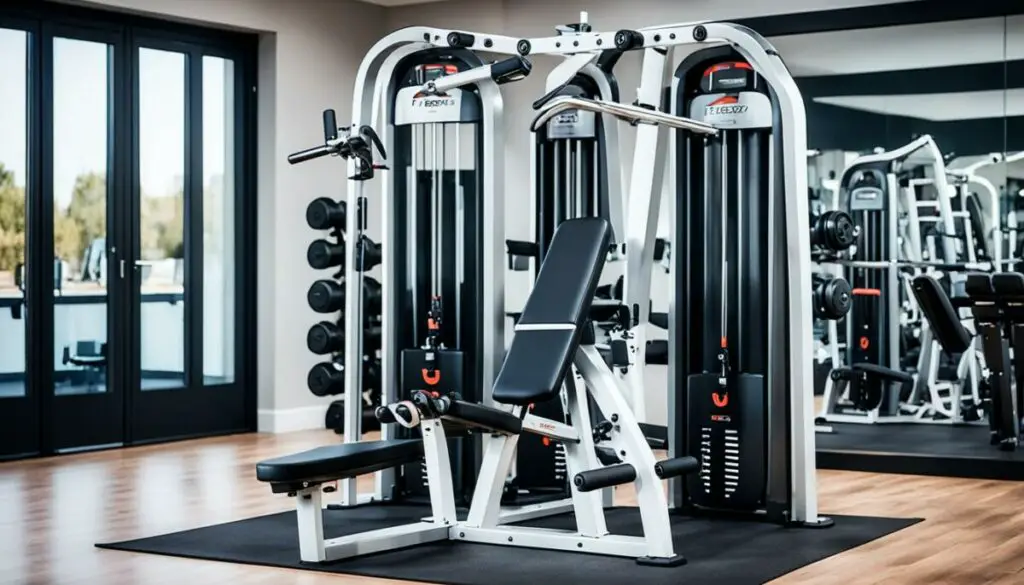
When it comes to time efficiency, incorporating time-efficient workouts into your fitness routine is essential. Both the chest press machine and the bench press have their advantages in terms of time efficiency. Let’s take a closer look at how these exercises compare in terms of time, allowing you to maximize your workout efficiency.
Chest Press: Quick Weight Adjustments
The chest press machine offers a time-efficient workout experience due to its quick weight adjustment feature. With the simple turn of a dial or the insertion of a pin, you can easily change the resistance level without the need to change plates or dumbbells between sets. This allows for seamless transitions and minimizes downtime, making it ideal for efficient workouts.
Bench Press: Greater Range of Motion and Stabilization
Although the bench press may require more time for weight adjustments, it offers a greater range of motion and engages more stabilizing muscles. This increased range of motion allows for a more comprehensive workout, targeting not only the chest but also the shoulders and triceps. Additionally, engaging more stabilizing muscles contributes to overall strength gains and improved muscle development.
While the bench press may require slightly more time for weight adjustments, the benefits it offers in terms of range of motion and muscle engagement make it a valuable exercise for those seeking time-efficient and effective workouts.
Quick Chest and Bench Workouts
For those looking for quick chest or bench workouts, incorporating drop sets or circuit-style training can further enhance time efficiency. These workout techniques involve performing a series of exercises with minimal rest between sets, maximizing the intensity and effectiveness of your workout within a shorter period. Both the chest press machine and the bench press can be adapted to these time-efficient training methods.
To illustrate the difference between the two exercises in terms of time efficiency, here is a comparative table:
| Chest Press Machine | Bench Press |
|---|---|
| Quick weight adjustments | Greater range of motion and muscle engagement |
| Minimizes the need to change plates or dumbbells | Requires more time for weight adjustments |
| Ideal for drop sets and circuit-style workouts | Maximizes overall strength gains |
Based on the table above, it’s clear that both the chest press machine and the bench press have their time-efficient benefits. Choosing between the two depends on your specific fitness goals and preferences. If you’re looking for quick and convenient weight adjustments, the chest press machine may be the preferable choice. However, if you value a greater range of motion and muscle engagement, the bench press is the ideal option.
In conclusion, both the chest press machine and the bench press offer time-efficient workout options. Incorporating these exercises into your fitness routine can help you make the most of your time at the gym, whether you’re aiming for quick chest workouts or overall strength gains.
Weight Capacity: Chest Press vs Bench Press

When it comes to weight capacity, understanding the limitations of different exercise equipment is crucial. In this section, we will compare the weight capacity of the chest press machine and the bench press, providing insights into their maximum resistances and their implications for progressive overload.
Chest Press Machine Weight Capacity
The chest press machine typically has a predetermined weight limit set by the manufacturer. This limit represents the maximum resistance that the machine can provide. Once you reach this maximum weight on the chest press machine, you won’t be able to add additional resistance to further challenge your muscles.
Bench Press Weight Capacity
On the other hand, the bench press offers more freedom in terms of weight capacity. With the use of a barbell, you can incrementally add weight plates as you get stronger and progress in your training. This allows for progressive overload, a fundamental principle in strength training that involves gradually increasing the amount of weight lifted to stimulate ongoing gains in strength and muscle development.
So, while the chest press machine limits your ability to continually challenge yourself with more resistance, the bench press provides the flexibility to keep pushing your limits and striving for greater strength.
While weight capacity is an essential consideration, it’s important to note that the actual weight used in both exercises should be appropriate for your fitness level and goals. Always prioritize proper technique, form, and safety over lifting the heaviest weights possible.
Transitioning from Chest Press to Bench Press
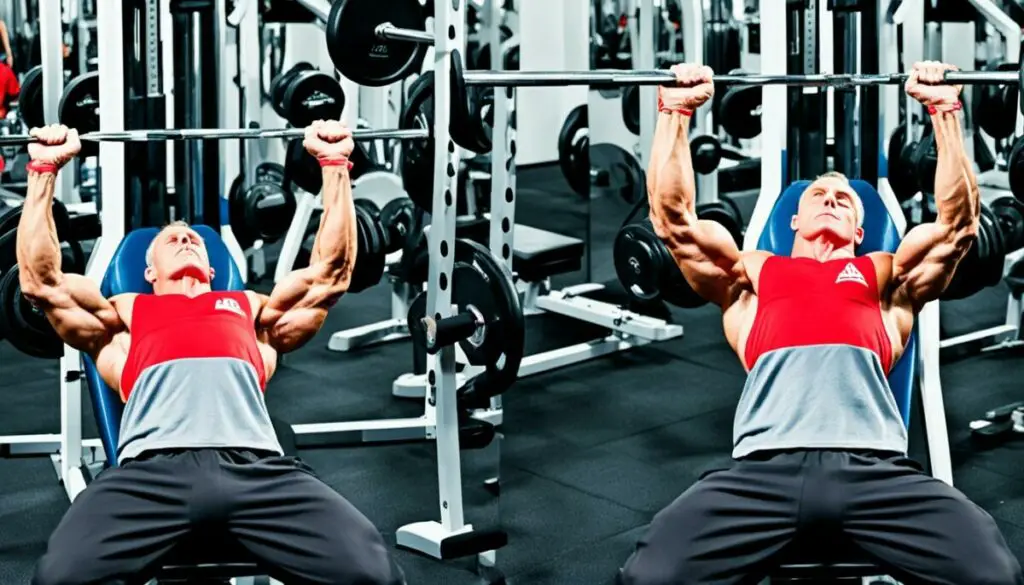
Transitioning from a chest press to a bench press requires a gradual progression to ensure proper form and prevent injuries. Here are some steps to help you make a smooth and effective transition:
- Learn the Basic Bench Press Technique: Start by familiarizing yourself with the proper technique for the bench press. Focus on your grip, positioning, and range of motion. Practice with lighter weights to master the form before progressing to heavier loads.
- Gradually Increase the Resistance: As you become comfortable with the bench press technique, gradually increase the weight resistance over time. This will allow your muscles and joints to adapt to the new movement and build strength progressively.
- Build Stability and Balance: The bench press requires more stability and balance compared to the chest press. Incorporate exercises that target your core, shoulder stabilizers, and triceps to enhance your overall stability and balance during the bench press.
- Start with Lighter Weights: When transitioning from the chest press to the bench press, you may find that the weights you can handle on the chest press machine are too heavy for the bench press. Begin with lighter weights on the bench press to focus on proper technique and gradually increase the load as your strength improves.
Remember, transitioning from the chest press to the bench press is a process that takes time and patience. Listen to your body and progress at a pace that is appropriate for you. By following these steps and maintaining consistency in your training, you can successfully adapt from the chest press to the bench press and enjoy the benefits of this challenging exercise.
Adapting to Bench Press for Injuries
When it comes to fitness, injuries can be a setback. However, individuals with existing injuries or limitations can still find ways to adapt their bench press or chest press exercises to accommodate their specific needs. By making modifications and working with qualified professionals, you can continue your fitness journey while ensuring proper form and injury prevention.
Working with a Qualified Professional
When dealing with injuries, it is crucial to listen to your body and seek guidance from a qualified professional, such as a physical therapist or personal trainer. They can assess your specific injury, provide expert advice, and customize an exercise plan tailored to your needs. Working with a professional can help you prevent further injuries and ensure that you are performing exercises correctly.
Modifications to Consider
Adapting the bench press or chest press for injuries may involve a range of modifications. Here are a few options to consider:
- Adjusting range of motion: Limiting the range of motion can reduce stress on injured areas. This can be achieved by using blocks or reducing the depth of the movement.
- Using lighter weights: Decreasing the weight lifted can help alleviate strain on injured muscles or joints. It allows you to focus on technique and gradually build strength without risking further damage.
- Alternative exercises: If the bench press or chest press aggravates your injury, incorporating alternative exercises that target the same muscle groups can be a viable option. For example, using dumbbells for chest flys or push-ups instead of the bench press.
Remember, these modifications are not one-size-fits-all solutions. The appropriate changes will depend on the nature and severity of your injury. Consultation with a professional is key to ensuring the proper modifications for your specific needs.
Smith Machine Bench Press vs Chest Press Machine
The Smith machine bench press and chest press machine are both popular options in the gym. While they may appear similar, there are key differences between the two. Let’s take a closer look.
Smith Machine Bench Press
The Smith machine bench press involves the use of a guided barbell on a fixed vertical plane. This provides added stability and control during the exercise. The barbell is attached to a series of hooks and can be adjusted to various heights, allowing for customization based on individual body dimensions and preferences.
The Smith machine bench press targets the chest, shoulders, and triceps as its primary muscle groups. The guided barbell path makes it easier to maintain proper form and reduces the risk of injury. The stabilization provided by the machine allows for heavier weights to be lifted safely, which can lead to increased strength gains over time.
Chest Press Machine
The chest press machine, on the other hand, consists of a seat and handles that are pushed forward using the chest muscles. This machine is designed to isolate the chest muscles and minimize the involvement of other muscle groups. The movement is typically on a fixed plane, providing stability and control.
The chest press machine primarily targets the pectoralis major, or the main chest muscle. It also engages the anterior deltoids and triceps to a lesser extent. The isolated movement of the chest press machine can be beneficial for individuals who want to specifically focus on building chest strength or have limited range of motion due to injury or other factors.
Differences between Smith Machine Bench Press and Chest Press Machine
Here’s a summarized comparison between the Smith machine bench press and the chest press machine:
| Smith Machine Bench Press | Chest Press Machine |
|---|---|
| Guided barbell path | Isolated movement |
| Engages multiple muscle groups (chest, shoulders, triceps) | Primary focus on chest muscles |
| Provides stability for heavier weights | Minimizes involvement of other muscle groups |
| Requires a spotter for safety | Lower risk of injury |
The choice between the Smith machine bench press and chest press machine ultimately depends on personal preference, goals, and available equipment. Some individuals may prefer the stability and added control of the Smith machine bench press, while others may enjoy the isolated movement and focus on chest strength offered by the chest press machine. Experimenting with both exercises can help you determine which one best suits your needs.
Conclusion
Converting from a chest press to a bench press can be a beneficial progression in your fitness journey. The bench press offers a more functional and challenging movement that engages multiple muscle groups, whereas the chest press machine provides a controlled and stable environment.
When deciding which exercise to prioritize, it’s important to consider your skill level, goals, time availability, and any existing injuries. Starting with lighter weights and focusing on proper form and technique is crucial to avoid injuries and maximize your strength gains.
Whether you choose to stick with the chest press machine or transition to the bench press, remember to listen to your body and progress at a pace that is appropriate for you. By taking these factors into account and staying dedicated to your fitness goals, you can optimize your workouts and achieve the results you desire.
FAQ
What are the differences between the chest press and bench press?
The chest press is a machine-based exercise that provides a controlled and stable environment, while the bench press is performed with a barbell on a bench and requires balancing the weight. The bench press also offers a greater range of motion and engages more stabilizing muscles.
Which muscles are targeted in the bench press and chest press?
Both exercises engage similar muscle groups, including the pectoralis major, anterior deltoid, triceps brachii, and biceps brachii. Depending on variations and body positions, other muscles such as the pectoralis minor, serratus anterior, obliques, quadriceps, abs, lower back, and calves may also be activated.
Is the bench press or chest press better for beginners?
For beginners, the chest press machine may be more suitable as it provides a stable environment and requires less skill and coordination compared to the bench press. However, the bench press offers more room for progression and muscle development.
Which exercise is more time-efficient, the chest press or bench press?
The chest press machine may be advantageous for time efficiency as it allows for quick weight adjustments without the need to change plates or dumbbells. The bench press, on the other hand, requires more time for weight adjustments but offers a greater range of motion and engages more stabilizing muscles.
Can I progressively increase the weight in the chest press?
The weight capacity of the chest press machine is usually set and cannot be exceeded. In contrast, the bench press with a barbell allows for progressive overload by incrementally adding weight plates as you get stronger.
How do I transition from a chest press to a bench press?
Start by learning the basic bench press technique with lighter weights, gradually increasing the resistance over time. Focus on building stability, balance, and strength in the chest, shoulders, and triceps. It’s important to listen to your body and progress at a pace that is appropriate for you.
Can I do the bench press or chest press if I have existing injuries?
Individuals with existing injuries or limitations may need to modify their bench press or chest press exercises to accommodate their specific needs. It is crucial to listen to your body and work with a qualified professional, such as a physical therapist or personal trainer, to ensure proper form and prevent further injuries.
What is the difference between the Smith machine bench press and chest press machine?
The Smith machine bench press provides a guided barbell path and stabilization, while the chest press machine offers a more isolated movement and stability. The choice between the two ultimately depends on personal preference, goals, and available equipment.
What are the key points to consider when converting from a chest press to a bench press?
When converting from a chest press to a bench press, it’s important to start with lighter weights, focus on proper form and technique, and progress gradually to avoid injuries and maximize strength gains. It’s also essential to consider your skill level, goals, time availability, and any existing injuries.

